Horse Discovery - Bits
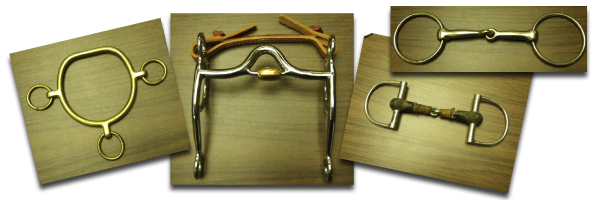
Bits
The tool or means by which the rider communicates his wishes to the horse. Bit Selection depends on style of riding, rider ability, intended use of the horse, and the level of the riders skills. Five Pressure Points are affected during the biting process: Bars, Tongue, Palate, Curb Strap Area and Poll.

- Stainless Steel - shiny, silver metal that does not rust; does not have a taste.
- Sweet Iron - has a dark color and is designed to rust; produces a sweet taste as it rusts.
- Copper - has flavor that encourages the horse to salivate.
- Rubber Mouth - may be regular, unflavored or apple flavored.
- Inlay and Combination - have a metal inlay such as sweet iron bits with copper inlay; may also have metal rollers.
Balance affects how the mouthpiece lays in the mouth and how release of pressure will remove curb strap pressure. Over/Under Balance also affects the timing, i.e. how fast the signal is felt by the horse.
Point of Balance in a bit is the mouthpiece.
- Over-Balanced- constructed to significantly release pressure when rein pressure is released.
- Balanced or Under-Balanced- bits that maintain pressure without rein pressure. Under-balanced bits are not frequently used, only on most experienced horses and riders.
To Determine Balance: Lay an unattached bit on your fingers, which are positioned under each end of the mouth piece. If the lower shanks on the bit hang forward of the mouthpiece and upper shanks drop backward, then the bit is over balanced. If the lower shanks lay behind the mouthpiece then the bit is underbalanced and therefore exerts more pressure on the horse’s poll.
Snaffle Bits
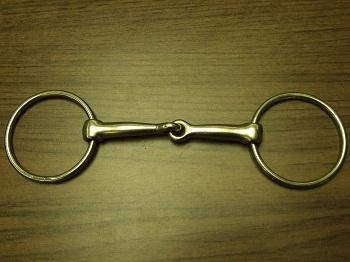
The term snaffle bit does not relate to the mouth piece being “broken” in the center. The term has to do with the fact that the bit has no leverage and exerts direct pressure on the side of the horse’s mouth, and are very useful to encourage lateral flexion. Snaffle bits can come with solid or broken mouthpieces.
Snaffle bits are typically used to start the biting process. The mouthpiece is attached to a ring (O-ring, D-ring, or an egg-butt). Since there is no leverage, no pressure is applied by a curb strap under the horse’s chin and and/or over the poll. Snaffles are constructed so the bridle headstall and reins are attached to the rings.
For Western style of riding, you may or may not use a chin strap attached to the snaffle bit. A chin strap may be useful to prevent the rings from sliding through the side of the horse’s mouth.
When a horse is bitted with a snaffle bit, the rider should hold the reins with 2 hands, one rein in each hand.

Mouthpiece is free to slide around the ring.
Used for daily training where lateral flexion is required.
The mouthpiece can be smooth or twisted, or covered in latex, and can also exist in different thickness. Smooth mouthpieces are generally more mild to the horse’s mouth. A mouthpiece that is fast twisted (very twisted) and also thin can be very harsh. On the other hand, a very fat mouthpiece can cause a gag reflex on the horse, especially horses with small mouths.
Low quality loose ring bits can pinch the corner of the horse’s mouth, and a bit guard can be useful in such situations.

Just as the Loose-ring snaffle, these bits exert direct action with the horse’s mouth, allowing for lateral flexion.
Mouthpiece does not rotate around the ring.
Spreads out pressure along outside of the horse’s mouth.
The mouthpiece on these bits can also be smooth or twisted.
Examples: D-Ring, Egg-Butt
Types of Snaffle Bits

This is one the most commonly used snaffle bits. This bit is a simple jointed snaffle, because there is only one joint in the mouthpiece (see French-link snaffle to see the difference).
This bit is commonly used when horses are first starting to be bitted.
When pressure is placed on the reins, the mouthpiece forms an angle which gives the tongue room, but can also put pressure on the roof of the horse’s mouth. It can also pinch the mouth in a “nutcracker” action.
The bit shown in the picture is a very mild smooth mouth bit.
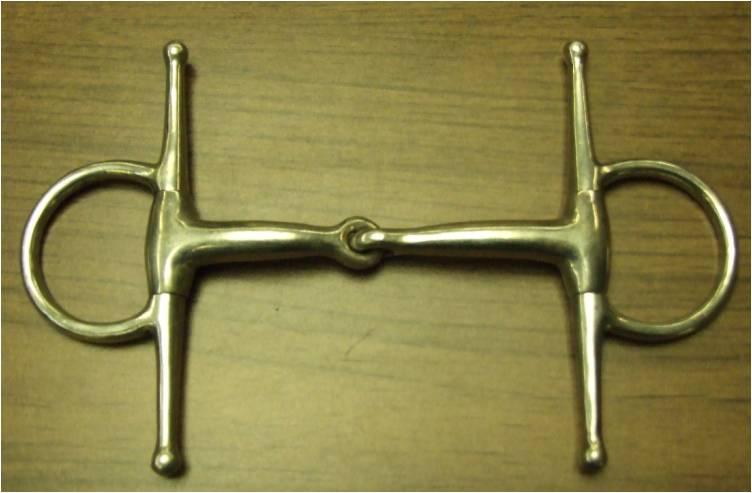
Cheek Pieces can be helpful in refining the turning aids and for preventing the bit from being pulled from the mouth.
Full Cheek Snaffles can have loose or fixed rings attached to the mouthpiece.
Full cheek snaffles are generally used with English bridles, as there is a place for attachment for the upper cheek on the nose band of some English Bridles.
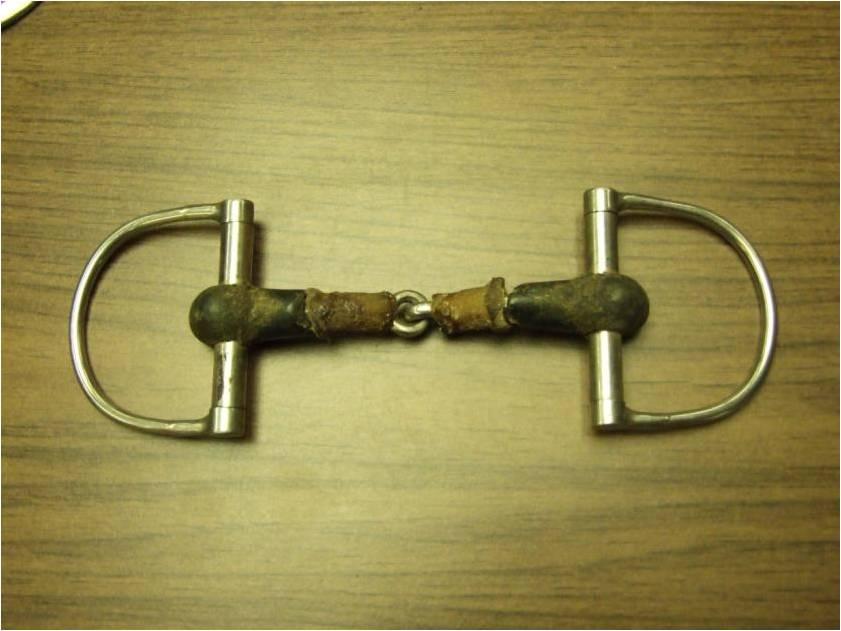
On the D-Ring snaffle, the ends of the mouthpiece merge into a hinge where the ring attaches.
The D shape keeps the corner of the mouth from being pinched between the mouthpiece and the rings.
You can have different types of mouthpieces. The one show here is covered with rubber, which is thought to be milder on the horse’s mouth. But as you can see, if the horse bites the bit, the rubber can chafe and the bit goes from mild to harsh and can cause mouth ulcers, cut the tongue of the horse and cause a horse to not enjoy being bitted. If the rubber mouthpiece becomes damaged, it needs to be changed.
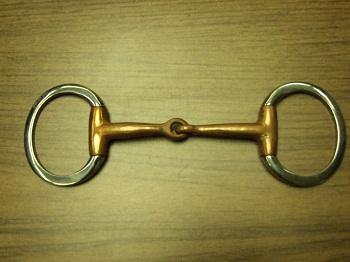
The egg-butt snaffle bit gets its name from the egg-shaped connection of the rings.
With this snaffle, there is less of a chance of the lip being pinched between the mouthpiece and the bit ring.
This is a widely used bit.
The particular bit shown here has a copper mouthpiece, which adds a taste to the bit that most horses enjoy.

The French Link snaffle is a multi-jointed snaffle, with a French link in the middle of the mouthpiece.
This snaffle is a good choice for horses with a low palate because this mouthpiece lays flat across the tongue. When both reins are pulled, this mouthpiece does not form an apex poking the horse on the roof of its mouth.
Horses with sensitive or large tongues may not like this mouthpiece because of the close contact with their tongue. This may create a gag reflex in such horses.
Dr. Bristol has a flat link in the mouth piece, as opposed to the French link, which is more rounded.

A chiffney is a horse bit that is used to control a horse when leading from the ground, and is not used when riding. This bit is attached to the horse’s halter, and it applies pressure to the horse’s jaw. It is commonly used in the racehorse industry.
Shank or Curb Bits
Curb bits are used with finished horses, and not horses that have just started training. These bits are used in Western disciplines, with the exception of double bridles and pelhams, which are used in English disciplines.
Curb bits exert pressure on the poll of the horse and encourage vertical flexion.
For these bits to work properly, there needs to be a curb strap/chain attached to the bit.
In Western style, riders hold reins in one hand, as these bits exert indirect pressure on the mouth of the horse, allowing for what some people refer to as “neck reining”. When showing in Western disciplines, riders may be required to hold reins in one hand only.
It is important to know that the longer the shanks of a bit, the greater the pressure exerted on the poll and mouth of the horse. Only experienced riders on finished horses should ride with long shank bits.
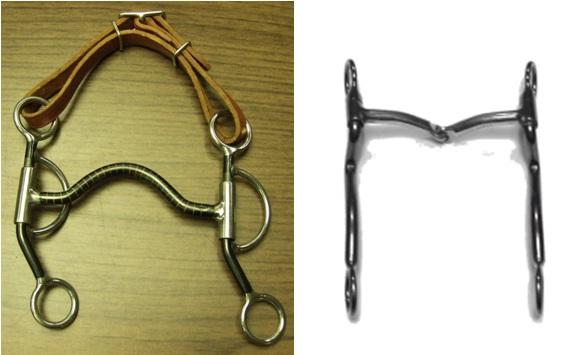
Allows the shank to swivel at the mouthpiece.
Used when transitioning horses from a snaffle to a shanked bit.
Flexibility allows the horse to produce saliva by moving the mouthpiece, signifying that the horse is more relaxed in the lower jaw.
Many bits with loose shanks have a broken mouth piece and are erroneously called by some people as a snaffle bit.
This bit is well accepted by horses because it allows space for their tongue.
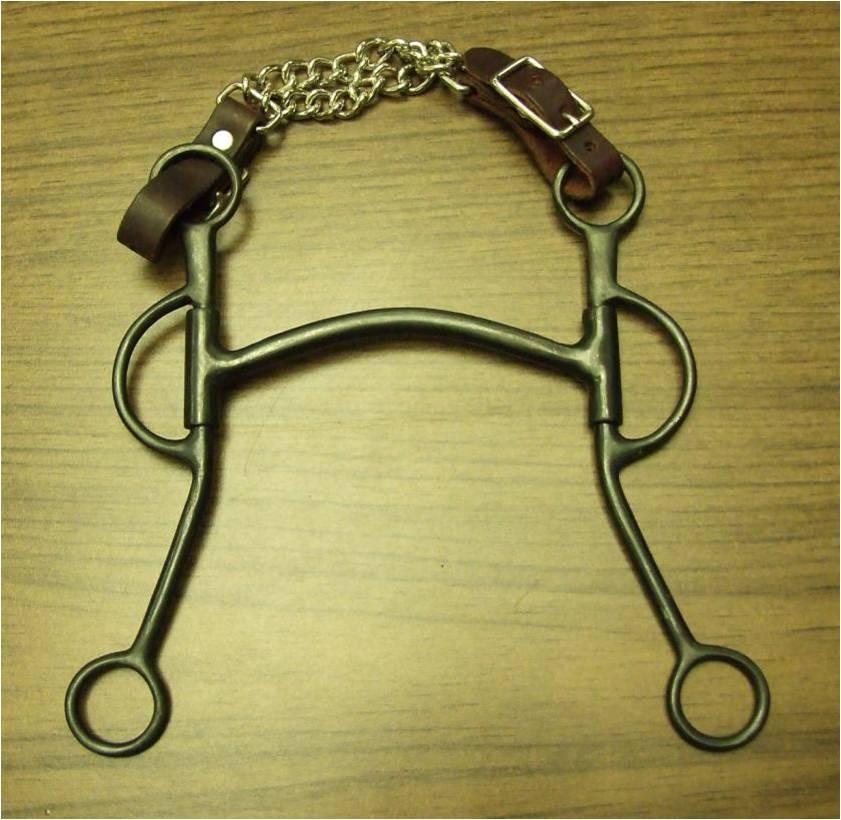
The name mullen refers to the mouthpiece. This is a loose shank bit with a mullen mouthpiece.
Has a slight curve and utilizes tongue pressure. When you depress the tongue, you exert pressure on the bars of the horse’s mouth.
The amount of curvature determines how much tongue and bar pressure results. The straighter the mouth piece, the greater the pressure it exerts on the tongue and bars.
Some horses may not like this bit because it allows little to no room for the tongue.
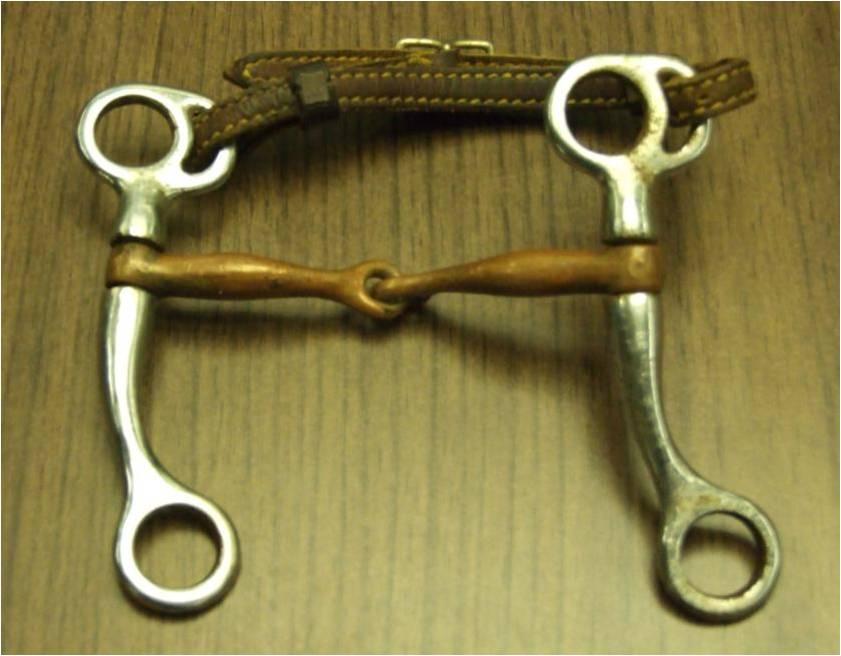
A Tom Thumb is one of the most commonly curb bits used in Western and pleasure riding.
A Tom thumb has a jointed mouthpiece and short shanks, and should always be used with a curb strap or chain.
This is a curb bit and should not be confused with a snaffle just because it has a broken mouthpiece.
Tom Thumb bits, like other curb bits, apply pressure to the poll when pressure is applied to the reins.
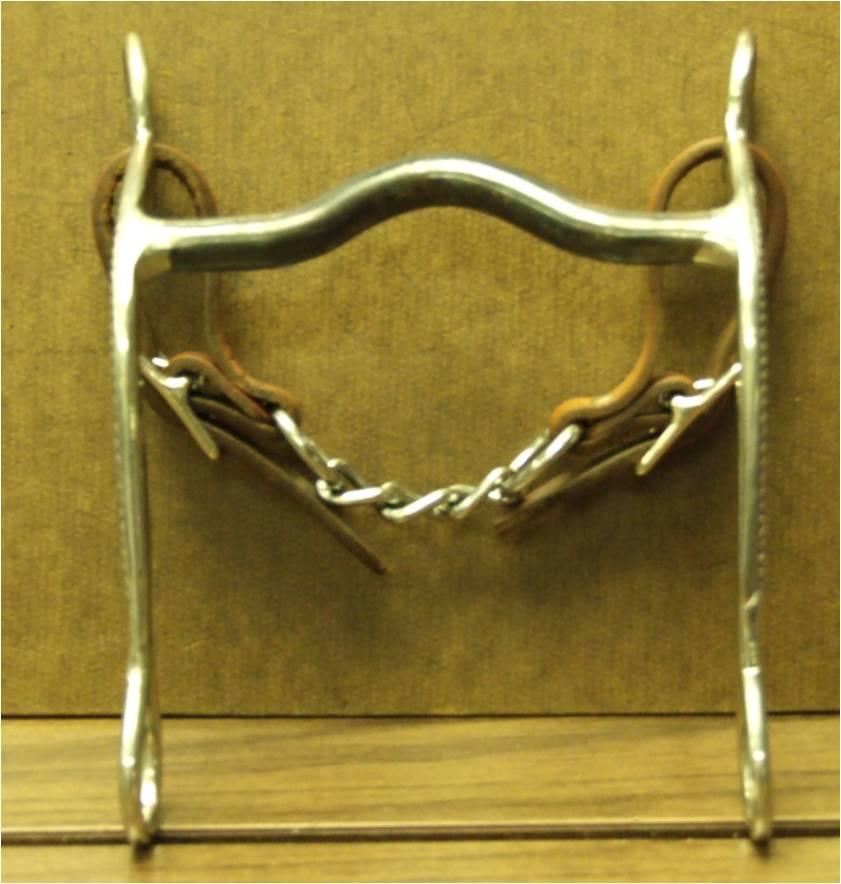
Solid mouthpiece affixed to a shank.
Used during shows.
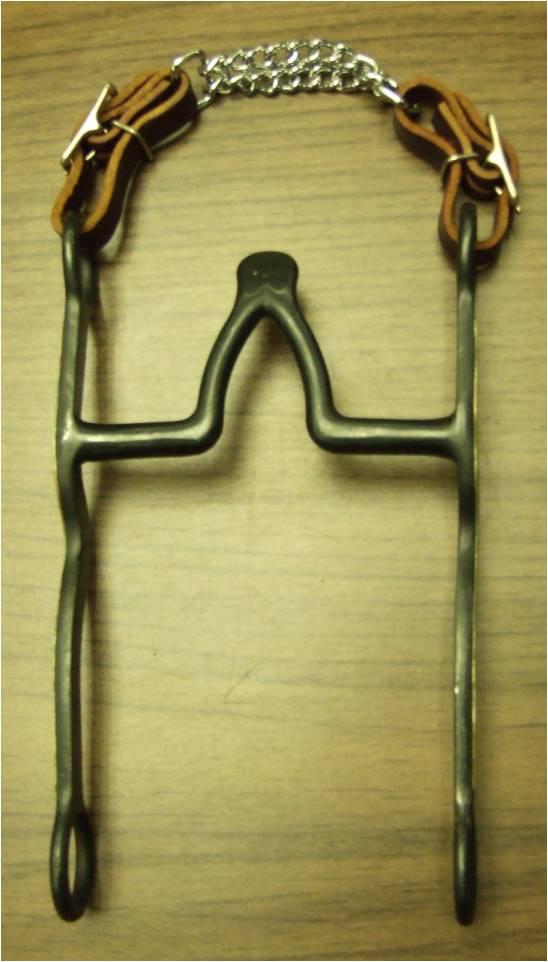
The name refers to the type of mouthpiece.
Has minimal tongue relief and no palate pressure.
Often used as a transition from a broken mouthpiece curb to a solid mouthpiece.
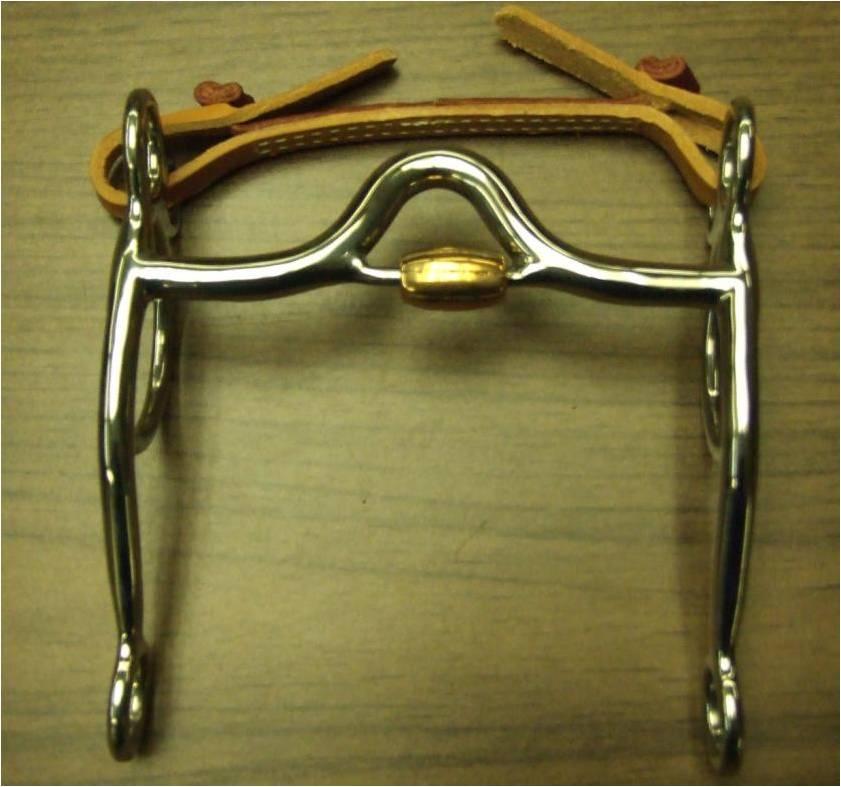
Horses like the taste of the copper and it also promotes salivation as horses use their tongues to play with the roller, keeping their jaws relaxed.

Generally used by Tennessee Walking Horses. Has a very long shank, which applies a lot of pressure on the poll, making the horse flex the head.

The Double Bridle has two bits, a snaffle (bradoon) and a curb bit. There are 2 sets of reins, one attached to the bradoon and one attached to the curb bit.
The reins attached to the bradoon will enable control of the horse’s lateral movement, exerting direct pressure on the mouth. The reins attached to the curb bit will enable the horse to flex on the poll and collect, lowering his head and arching his back.
Only finished horses and very skillful riders can use a double bridle. Also, only a few disciplines allow horses to show in a double bridle.
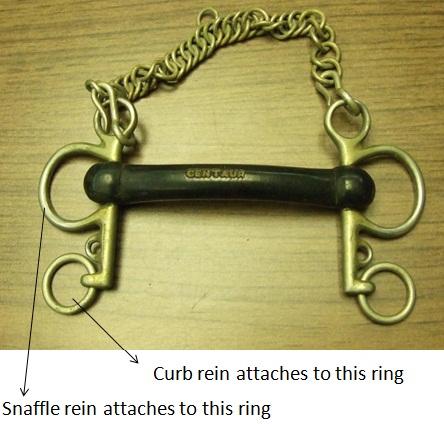
The Pelham combines the actions of the curb bit and a snaffle without having to use both, such as a double bridle.
This bit is best for horses that are uncomfortable in a double bridle but signals may not be as clear to the horse when using this bit, as compared to the double bridle.
The Pelham has attachment for reins near the mouthpiece and at the end of the shank.
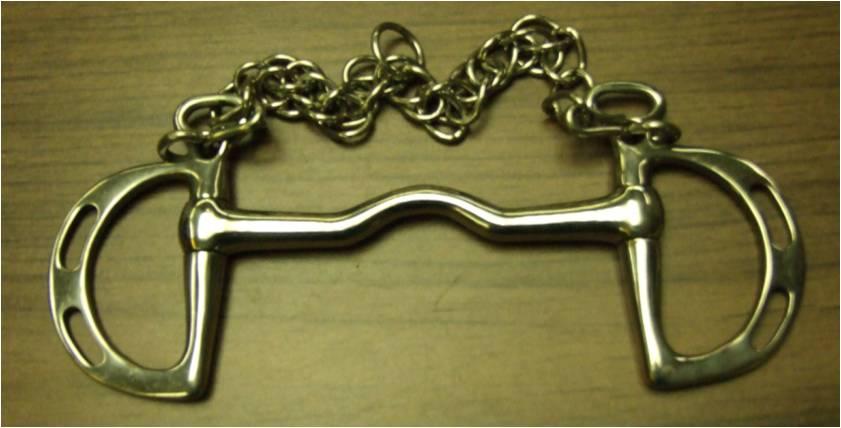
The Kimberwick can be used as a Snaffle, if the reins are attached to the rings, or as a shank bit, if the reins are attached to the holes on the outside of the ring.

Once you have read through the Bits section on our Horse Discovery page, you can test your knowledge here. The quiz will provide automatic grading and reveal the correct answers for learning purposes.
Take the Bits Knowledge Check here.
Did you score an 80% or higher? Congratulations! Email anna.draeger@uky.edu with a screenshot of your score to receive your celebratory Certificate of Completion for the Bits section.
Horse Discovery Navigation |
